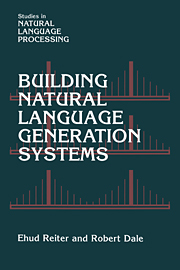Book contents
2 - National Language Generation in Practice
Published online by Cambridge University Press: 25 August 2009
Summary
Before commencing our exploration of the technical content of work in natural language generation, in this chapter we take a step back and consider questions that arise when we look at putting nlg technology to work. We consider alternatives to nlg, and we discuss the circumstances under which it is appropriate to use nlg technology. We also look at requirements analysis and the evaluation and fielding of nlg systems. These topics are rarely discussed in the research literature but are of major significance when we are concerned with the construction of an operational natural language generation system.
Introduction
Research activity in natural language generation is sometimes carried out with relatively little attention being paid to how the fruits of the research might be transferred into a working environment. This approach may be entirely appropriate for work that focuses on research issues where even the questions to be asked are unclear; it can often be useful to abstract away from situations of use to clarify the underlying issues.
In this book, however, we also are concerned with how nlg technology can be used to build real working systems that are intended to be put into everyday use. This means that we have to think about issues such as the specification of system requirements and the problems that can arise in fielding systems.
- Type
- Chapter
- Information
- Building Natural Language Generation Systems , pp. 23 - 40Publisher: Cambridge University PressPrint publication year: 2000



